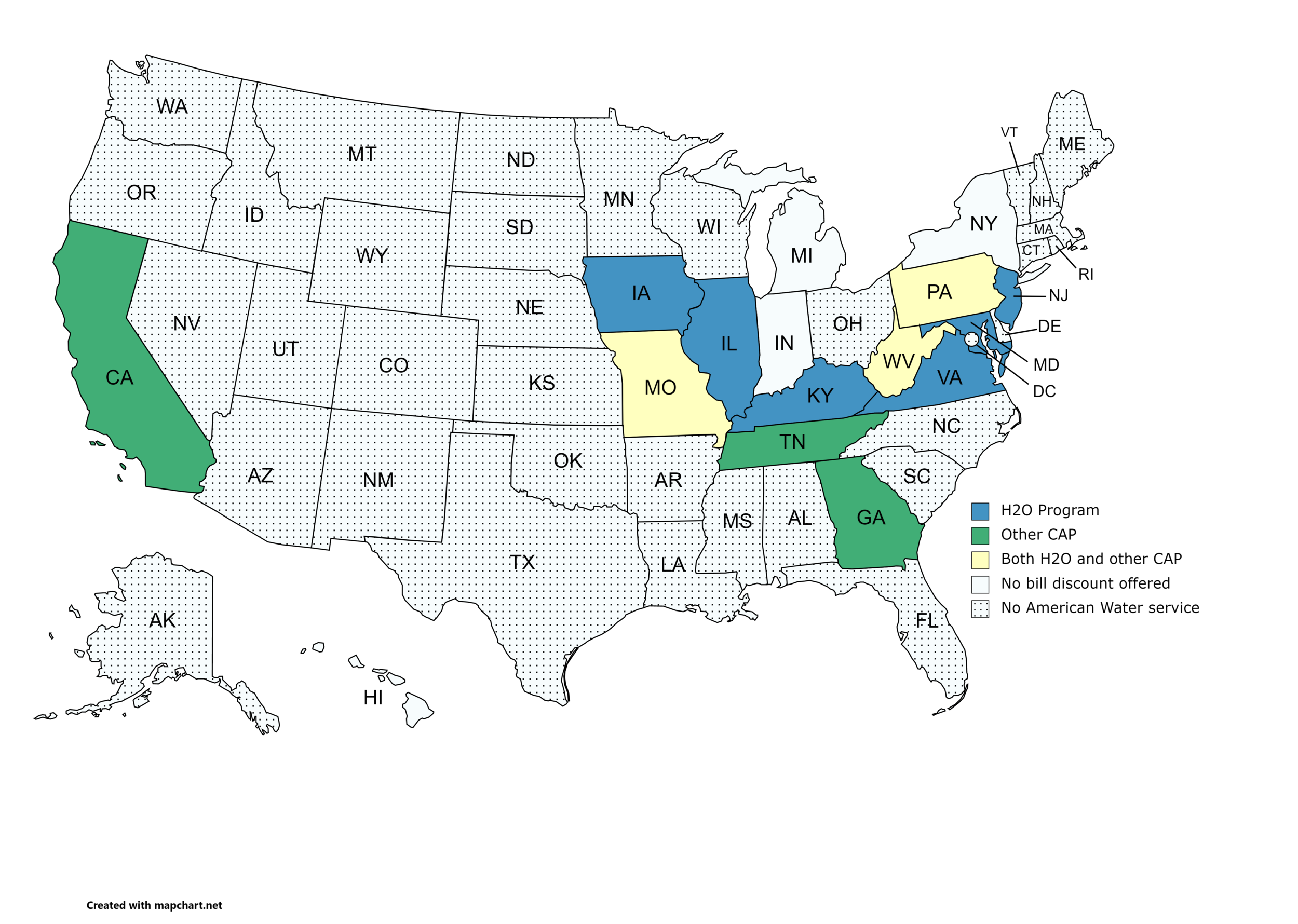Missouri American Water: Varying Benefits for Customers Spread Across Jurisdictions
Three of the 20 utilities analyzed in this report are private utilities, of which two are investor-owned. American Water in Missouri and Suez Water in New Jersey represent two of the country's largest private water utilities. Depending on state legislation, a private utility has numerous advantages in administering customer assistance programs. Missouri American Water serves 1.1 million residents in the state, spread across numerous counties.
County map of Missouri showing variation in administration of Missouri American Water’s billing assistance program
In Missouri, American Water offers two CAPs that are administered quite differently. In Brunswick, Platte County, and St. Joseph District, a low-income assistance program is offered to customers with a ⅝" meter who qualify through LIHEAP. The total bill discount is eighty percent off the fixed rate charge of the water bill. However, for all other counties and districts in the water service area, the only CAP offered is H2O Help to Others, which is entirely administered by local community action agencies.
Across the country, H2O Help to Others is the most frequently offered CAP by American Water. While the name of the program is consistent across all American Water subsidiaries through the U.S., the assistance varies from across and within states. Of the 16 states American Water operates in, nine offer H2O Help to Others; six of them only offer this one program, while the rest offer both H2O Help to Others and another CAP. Additionally, three utilities have a CAP other than H2O Help to Others, and four offer no type of assistance at all.
A map of the U.S. showing variation in American Water’s low-income assistance programs.
Source: Developed by authors using mapchart.net
Unlike American Water in Missouri, many of the H2O Help Others programs are administered by one community agency (Table S1 in the Appendix). The Dollar Energy Fund is the largest administrator of these programs for American Water across the country. Consolidating the administrative efforts into one community agency showed noticeable benefits. Programs administered by the Dollar Energy Fund contained substantially more information for customers. For example, American Water Pennsylvania gives breakdowns on expected aid, income requirements, and even promotes an instructional Youtube video. We hypothesize that third-party organizations that solely provide utility bill assistance like the Dollar Energy Fund are more equipped to handle customer concerns on this issue than general purpose organizations like the Salvation Army, but we currently do not have sufficient evidence to make a determination.
The most frequent third-party provider, Community Action Agency of St. Louis, lacks an online application and any information on expected assistance, and requires households to be below 125 percent of the federal poverty level. The Community Action Agency based in Jefferson Franklin lacks any mention of the H2O program on its website. The criteria and administration of these programs are left entirely up to the community action agency. The only guideline for achieving assistance set by American Water is that a household meets the "'basic needs' criteria as set by Community Action Agency caseworkers." The unclear thresholds potentially contribute to the participation rates hovering in the "10 to 20 percent range."
In New Jersey, Suez Water administers its CAP similar to American Water through a third-party organization. However, in this case, that third-party organization, Suez Cares, is a nonprofit created by Suez Water. On Suez Water's website, there is no link to Suez Cares and no information other than a phone number located under the "Collections FAQ" tab. There is no downloadable or electronic application, and no eligibility requirements stated.
In both cases, the utilities' reliance on third-party organizations like the community action agency creates a disconnect between the utility and the customer. The utility makes donations to the program but are largely uninvolved and seemingly uninterested in the welfare of their customers. Despite the differences between public and private water utilities in administering the CAP, both deal with fairly similar issues.
Representatives from American Water and their trade group, the National Association of Water Companies, highlighted affordability concerns for renters, especially non-account holders, as a key priority. American Water's California and Pennsylvania subsidiaries experience higher rates of participation in CAPs, likely attributed to the stronger role played by the Public Utilities Commission. In both states, the PUC has jurisdiction over rate setting for private water utilities, and state legislation allows private utilities to use rate revenues to fund CAPs. In the words of Rik Hull of the National Association of Water Companies, "funding drives the program." Reliable, ample, and diverse funding streams can support a vigorous CAP in conjunction with a well-administered program.




